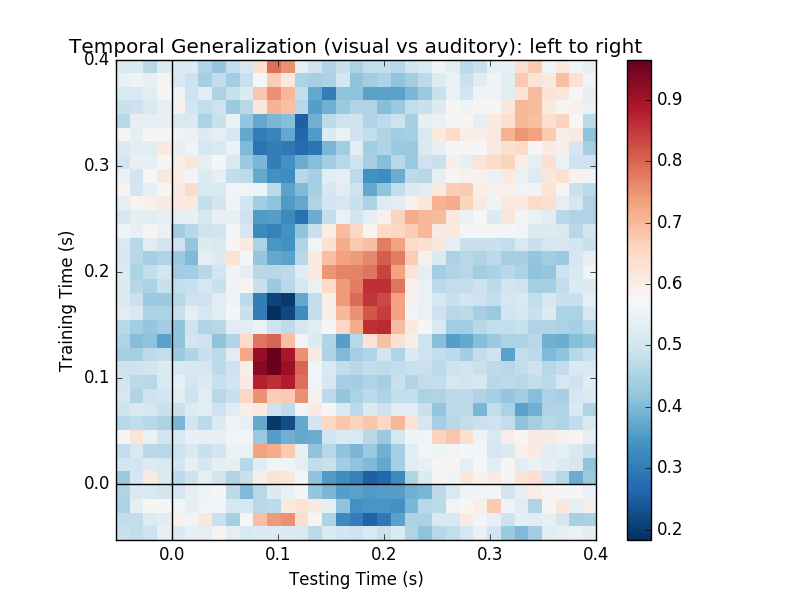This example runs the analysis described in [1]. It illustrates how one can fit a linear classifier to identify a discriminatory topography at a given time instant and subsequently assess whether this linear model can accurately predict all of the time samples of a second set of conditions.
| [1] | King & Dehaene (2014) ‘Characterizing the dynamics of mental representations: the temporal generalization method’, Trends In Cognitive Sciences, 18(4), 203-210. doi: 10.1016/j.tics.2014.01.002. |

Out:
Opening raw data file /home/ubuntu/mne_data/MNE-sample-data/MEG/sample/sample_audvis_filt-0-40_raw.fif...
Read a total of 4 projection items:
PCA-v1 (1 x 102) idle
PCA-v2 (1 x 102) idle
PCA-v3 (1 x 102) idle
Average EEG reference (1 x 60) idle
Range : 6450 ... 48149 = 42.956 ... 320.665 secs
Ready.
Current compensation grade : 0
Reading 0 ... 41699 = 0.000 ... 277.709 secs...
Setting up band-pass filter from 1 - 30 Hz
l_trans_bandwidth chosen to be 1.0 Hz
h_trans_bandwidth chosen to be 7.5 Hz
Filter length of 991 samples (6.600 sec) selected
The unique classes' labels are: [0 1]
score_mode changed from mean-fold-wise set to 'mean-sample-wise' because predict_mode is 'mean-prediction'.
# Authors: Jean-Remi King <jeanremi.king@gmail.com>
# Alexandre Gramfort <alexandre.gramfort@telecom-paristech.fr>
# Denis Engemann <denis.engemann@gmail.com>
#
# License: BSD (3-clause)
import numpy as np
import mne
from mne.datasets import sample
from mne.decoding import GeneralizationAcrossTime
print(__doc__)
# Preprocess data
data_path = sample.data_path()
# Load and filter data, set up epochs
raw_fname = data_path + '/MEG/sample/sample_audvis_filt-0-40_raw.fif'
events_fname = data_path + '/MEG/sample/sample_audvis_filt-0-40_raw-eve.fif'
raw = mne.io.read_raw_fif(raw_fname, preload=True)
picks = mne.pick_types(raw.info, meg=True, exclude='bads') # Pick MEG channels
raw.filter(1, 30, method='fft') # Band pass filtering signals
events = mne.read_events(events_fname)
event_id = {'AudL': 1, 'AudR': 2, 'VisL': 3, 'VisR': 4}
decim = 2 # decimate to make the example faster to run
epochs = mne.Epochs(raw, events, event_id, -0.050, 0.400, proj=True,
picks=picks, baseline=None, preload=True,
reject=dict(mag=5e-12), decim=decim, verbose=False)
# We will train the classifier on all left visual vs auditory trials
# and test on all right visual vs auditory trials.
# In this case, because the test data is independent from the train data,
# we test the classifier of each fold and average the respective predictions.
# Define events of interest
triggers = epochs.events[:, 2]
viz_vs_auditory = np.in1d(triggers, (1, 2)).astype(int)
gat = GeneralizationAcrossTime(predict_mode='mean-prediction', n_jobs=1)
# For our left events, which ones are visual?
viz_vs_auditory_l = (triggers[np.in1d(triggers, (1, 3))] == 3).astype(int)
# To make scikit-learn happy, we converted the bool array to integers
# in the same line. This results in an array of zeros and ones:
print("The unique classes' labels are: %s" % np.unique(viz_vs_auditory_l))
gat.fit(epochs[('AudL', 'VisL')], y=viz_vs_auditory_l)
# For our right events, which ones are visual?
viz_vs_auditory_r = (triggers[np.in1d(triggers, (2, 4))] == 4).astype(int)
gat.score(epochs[('AudR', 'VisR')], y=viz_vs_auditory_r)
gat.plot(title="Temporal Generalization (visual vs auditory): left to right")
Total running time of the script: ( 0 minutes 6.710 seconds)